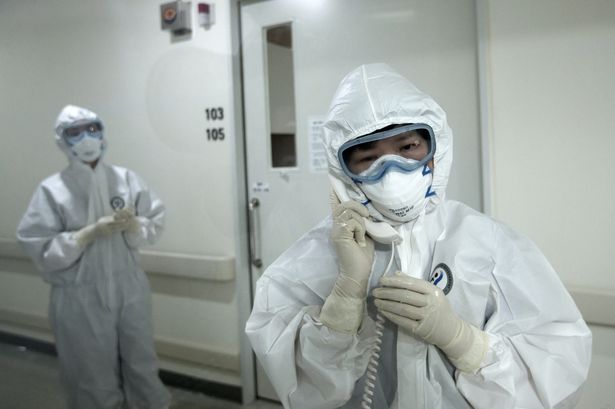- California Assembly OKs highest minimum wage in nation
- S. Korea unveils first graphic cigarette warnings
- US joins with South Korea, Japan in bid to deter North Korea
- LPGA golfer Chun In-gee finally back in action
- S. Korea won’t be top seed in final World Cup qualification round
- US men’s soccer misses 2nd straight Olympics
- US back on track in qualifying with 4-0 win over Guatemala
- High-intensity workout injuries spawn cottage industry
- CDC expands range of Zika mosquitoes into parts of Northeast
- Who knew? ‘The Walking Dead’ is helping families connect
WHO team puzzled by MERS behavior

A health care worker wearing full-body protective gear as a precaution against the Middle East Respiratory Syndrome virus talks on an intercom inside an isolation ward at Seoul Medical Center in Seoul, South Korea Wednesday, June 10, 2015. South Korea believes its MERS virus outbreak may have peaked, and experts say the next several days will be critical to determining whether the government’s belated efforts have successfully stymied a disease that has killed seven people and infected nearly 100 in the country. (Yonhap)
By Jung Min-ho
The World Health Organization (WHO) is looking closely into the characteristics and clinical features of the Middle East Respiratory Syndrome (MERS) virus, which has clearly “behaved differently” in Korea, a member of the visiting WHO team told The Korea Times, Wednesday.
The government has said that it has not found any genetic mutation in the virus.
The Ministry of Health and Welfare is still looking to find out why it spread more rapidly — with a lower fatality rate — here.
Communications Officer Margaret Harris said there are many other factors to consider before determining why its fatality rate remains below 10 percent, which is much lower than the global average of 40 percent, and its infection rate is oddly high.
“Genetic changes do not necessarily affect how the virus behaves,” she said. “What is important is to match a change in the virus’ patterns with any changes in genetic makeup. In other words, sequencing only gives us one piece of the puzzle not the whole picture.”
She also noted that the joint WHO and ministry team might conduct further sequencing to determine whether the virus has really not changed here.
“In Korea, the death rate is considerably lower, much lower, than in Saudi Arabia. This is an interesting question. Is it because people are less ill or is it the treatment?” She said, “You also need to look at the epidemiology, the effect on the population, along with the change in the genetic sequence until you really know.”
She noted that the team is examining whether different treatments here somehow affected MERS patients.
“We are talking to the clinicians who have been looking after the different patients and what they’ve done and how they’ve done it,” she said. “But certainly, it’s some good news that most of the people who have gone to the hospital have done well.”
Harris also talked about challenges the team is facing. She said research methods such as a “randomized controlled trial” are very difficult to be used in the middle of an emergency like this.
The results of the team’s investigation will be made public Saturday.
Meanwhile, some experts, including Korea University’s medical school professor Song Ki-joon and Chung-Ang Universtiy’s pharmacy school professor Sul Dae-woo, still remain unconvinced that the virus in Korea is exactly the same one from Saudi Arabia, a test result announced by the ministry last week.
Speaking to No Cut News, a local daily, Sul said the fatality or infection rate could change dramatically even if the viruses are 99.99 percent identical genetically.
“Even one amino acid sequence change can make such a difference,” Song said. For example, the genetic makeup of humans and chimpanzees is 99 percent the same but they are very different in many ways, he noted.
Sul also pointed out that ministry should not have used samples from the nation’s second MERS patient because it takes time for a virus to mutate. Due to this, he said, the ministry’s results are hard to trust.
MERS is caused by a coronavirus, which is known to be adept at adapting to new hosts. MERS is considered as a medical mystery. The disease is widely found in dromedary camels. But most MERS patients have no contact with the animals, like many cases confirmed in Korea. Also, it is unknown how and where the camels were infected with the virus in the first place.
















Pingback: christian louboutin shoes outlet